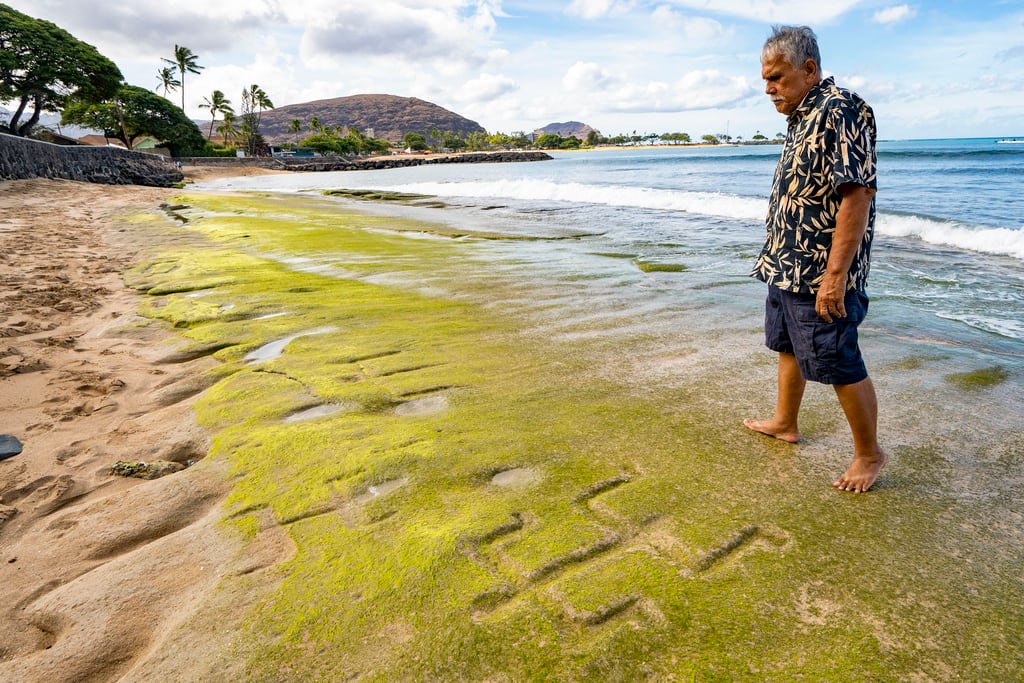Hawaii’s WAIANAE (AP) Seasonal ocean swells that remove sand from a panel of over two dozen images of primarily human-looking stick figures have revealed Hawaiian petroglyphs from at least a half-millennium ago on Oahu for the first time in years.
At low tide, when soft waves wash across slick, neon-green algae growing on a section of sandstone, the petroglyphs are easily visible. For the first time since they were discovered nine years ago by two visitors vacationing at a bayside U.S. Army recreation complex in Waianae, which is approximately an hour’s drive from Honolulu, the complete panel of petroglyphs is visible.
Glen Kila, a Native Hawaiian cultural practitioner who can trace his ancestry back to the aboriginal families of this coastal community in Hawaii, said he thinks the traditional marvels’ reappearance is a message from his ancestors.
Kila, a well-known authority on Waianae culture and history who advises the Army on petroglyph preservation, said it’s communicating to the community that the ocean is rising.
Army officials are attempting to strike a compromise between the petroglyphs’ accessibility on a public beach and their protection.
After hearing a local TV program on the petroglyphs, John and Sandy Stone drove around 30 minutes from their home early Tuesday to catch a glimpse, consulting tidal maps along the way.
John Stone, who divides his time between California and Hawaii, stated that touching them was fascinating. Having that sort of link to the past felt intriguing.
According to Laura Gilda, an archaeologist with the U.S. Army Garrison Hawaii, petroglyphs are hard to date, although an archeological site nearby dates to roughly 600 years ago. Kila claims that at least 1,000 years ago, Hawaiians came to Waianae.
Shift in waves caused petroglyphs to appear
According to an Army assessment on the petroglyphs, the beach here varies in size and profile every year, with waves removing loose sand from shorelines and redepositing it farther out due to low-pressure weather systems that emerge in the eastern Pacific between May and November. Their brief exposure is probably caused by that change.
A total of 26 petroglyphs were discovered by archaeologists. According to the article, eight of the 18 anthropomorphic stick figures have what may be male genitalia, while the other characters are gender-neutral.
According to Gilda, the complete panel is roughly 115 feet (35 meters) long.
The sand was washed away by high wave activity from late spring and early summer storms, including hurricanes, when the petroglyphs first resurfaced in July 2016, according to Gilda.
For a while, they were visible before being covered once more.
Gilda stated that although some parts of the panel have been made public since then, this summer marks the first time the entire panel has been made public once more.
Petroglyphs are telling a religious story, expert says
The lineal petroglyphs seem to be narrating a religious, ceremonial tale, according to Kila’s education. The biggest image, which seems to have hands and fingers with one arm up and the other down, is interpreted by him as the sun rising and setting.
According to Kila, his great-great grandmother refused to leave when the military seized the area in the 1930s and forced out Native Hawaiians, including his family, who had lived there for centuries. As a result, his family traded mountain grounds with a coffee plantation so that she could stay close to the bay.
He described growing up in Waianae without television in an interview that was part of the Army’s study. He claimed that the mountains and water served as our playground. According to Kila, the seawall served as a barrier between Native Hawaiians and the military, and the Army leisure area was closed to the general people.
Kila, who is now 72, recounted that military police would beat and push them away if they walked on top of the wall.
Because we were proud and aware of our origins, we never instilled animosity toward the soldiers because we thought that one day the land will be returned to us, he said.
Kila told The Associated Press during a visit to the petroglyphs earlier this week that the Army’s decision to conserve them signifies a change in the relationship between the community and the site.
Gilda stated that officials have been struggling with how to preserve the petroglyphs while simultaneously sharing them with the community.
To what extent do you wish to draw attention to this area? “When they’re not exposed, you don’t really want people to go looking for them,” she said. However, they’re undoubtedly fantastic to view on the public beach.
The petroglyphs were photographed Tuesday by Donald Kauli, a Native Hawaiian who grew up in Waianae. He claimed that seeing them confirms that our forefathers came from this area.






